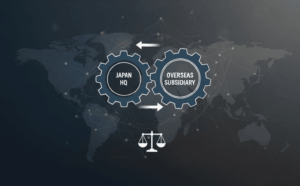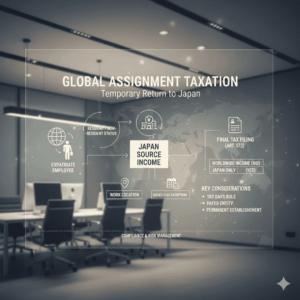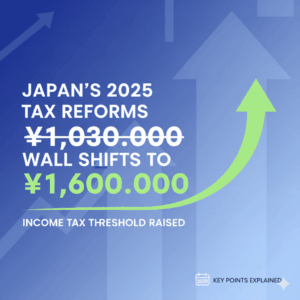Essential International Tax Knowledge
In today’s globalized world, many companies regularly conduct overseas business trips and short-term assignments. A crucial concept that must be understood in such situations is the “short-term resident exemption system.” By correctly understanding and utilizing this system, companies can prevent double taxation of foreign employees during their stay in Japan and reduce their tax burden.
The short-term resident exemption system is an important mechanism in international taxation based on tax treaties, particularly known as the “183-day rule.”
Basic Concepts and Purpose of the Short-Term Resident Exemption System
The short-term resident exemption system is a mechanism whereby foreign nationals earning employment income in Japan can be exempted from Japanese income tax and taxed only in their country of residence, provided certain requirements are met. This system is stipulated in tax treaties concluded between countries and primarily aims to prevent international double taxation.
For example, when an employee of a U.S. company goes on a short-term business trip to Japan, they would normally be subject to income tax in both Japan and the United States. However, if the short-term resident exemption system applies, taxation in Japan would be exempted, and they would only be taxed in the United States. This enables smooth international personnel exchanges from a tax perspective.
This system is also called the “183-day rule” and is based on Article 15, Paragraph 2 of the OECD (Organization for Economic Co-operation and Development) Model Tax Convention. Similar systems are operated in countries worldwide. In Japan, this system is stipulated in tax treaties with various countries, including the Japan-U.S. Tax Treaty and the Japan-Korea Tax Treaty.
OECD Model Tax Convention Article 15, Paragraph 2
Here we introduce Article 15 (Income from Employment), Paragraph 2 of the OECD Model Tax Convention.
Article 15 (Income from Employment) Paragraph 2 Text (OECD Model Tax Convention 2017 Edition, English)
- Notwithstanding the provisions of paragraph 1, remuneration derived by a resident of a Contracting State in respect of an employment exercised in the other Contracting State shall be taxable only in the first-mentioned State if:
(a) the recipient is present in the other State for a period or periods not exceeding in the aggregate 183 days in any twelve month period commencing or ending in the fiscal year concerned, and
(b) the remuneration is paid by, or on behalf of, an employer who is not a resident of the other State, and
(c) the remuneration is not borne by a permanent establishment which the employer has in the other State.
OECD Model Tax Convention Article 15, Paragraph 2 (Reference)
Article 15 (Income from Employment) Paragraph 2
Notwithstanding the provisions of paragraph 1, remuneration from employment exercised by a resident of a contracting state in the other contracting state shall be taxable only in the first-mentioned state of residence if all of the following conditions are met:
(a) The recipient does not stay in the other state for a total period exceeding 183 days in any 12-month period beginning or ending in the relevant tax year.
(b) The remuneration is paid by, or on behalf of, an employer who is not a resident of the other state.
(c) The remuneration is not borne by a permanent establishment that the employer has in the other state.
Purpose (Commentary)
General Rule (Paragraph 1)
Employment income is taxed in the country where the work is performed (country of employment).
Exception (Paragraph 2: 183-Day Rule)
Short-term residents who meet the following conditions:
Stay not exceeding 183 days,
Employer paying remuneration is not a resident of the country of employment,
Remuneration is not attributable to a permanent establishment in the country of employment,
If these conditions are met, taxation in the country of employment is exempted, and taxation occurs only in the country of residence.
This is the provision that serves as the basis for the so-called “short-term resident exemption.”
Three Basic Requirements for Short-Term Resident Exemption
For the short-term resident exemption system to apply, all of the following three requirements must be met. These requirements are international standards based on the OECD Model Tax Convention.
| Requirement | Detailed Content | Key Assessment Points |
|---|---|---|
| Stay Period Requirement | 183 days or less in a tax year or consecutive 12 months | Actual stay days including entry and departure dates |
| Remuneration Payer Requirement | Remuneration is not paid by a Japanese resident | Salary payment from overseas company is essential |
| PE Burden Prohibition Requirement | Employer’s Japanese PE (permanent establishment) does not bear the remuneration | No salary burden by Japanese branches, etc. |
The most important “stay period requirement” uses 183 days as the international standard. This 183 days corresponds to approximately half a year and functions as a clear criterion to distinguish between short-term and long-term stays. The number of stay days includes weekends and holidays, and in cases of multiple entries and exits, the total number of days is used for assessment.
In the “remuneration payer requirement,” the actual bearer of salary costs is the crucial point. If a Japanese subsidiary bears even part of the salary, the exemption does not apply even if it’s nominally paid by an overseas head office. Also, in the “PE burden prohibition requirement,” it is required that there be no salary burden by permanent establishments (branches, offices, factories, etc.).
Correct Calculation Method for the 183-Day Rule
The calculation method for the 183-day rule may vary slightly depending on the concluded tax treaty. Accurate understanding is crucial as it determines the success or failure of system application, so it’s important to grasp the detailed calculation rules.
The Japan-U.S. Tax Treaty counts stay days in “the tax year or any 12-month period beginning or ending.” This means that even when staying across years, exemption may apply if the stay does not exceed 183 days within any consecutive 12-month period. On the other hand, the practical commentary of the Japan-Korea Tax Treaty suggests counting on a “calendar year basis (that year),” and this difference is a very important point in determining system application.
In calculating stay days, both entry and departure dates are generally included. Additionally, unexpected stay extensions due to illness are also included in the count, so it’s important to plan stays with sufficient margin. However, temporary stays in Japan for aircraft transit usually are not included in the stay count.
PE (Permanent Establishment) Concept and Assessment Criteria
Permanent Establishment (PE) is an extremely important concept in international taxation. PE refers to a permanent base of business activities that a foreign company has domestically, specifically including branches, offices, factories, warehouses, construction sites, etc.
The short-term resident exemption system requires that PE does not bear the remuneration. This is because when salary payment or business activities are conducted through a PE in Japan, it is substantially considered Japanese business activity, and taxation in Japan is deemed appropriate.
A common practical case involves U.S. head office employees working at a Japanese branch with the Japanese branch bearing the salary costs. In this case, even if the stay period is 183 days or less, short-term resident exemption does not apply because there is salary burden by the PE (Japanese branch). Conversely, if the same employee works in Japan but the U.S. head office bears the full salary cost, exemption may be possible.
Practical Procedures and Tax Treaty Application Notification
Even if the requirements for short-term resident exemption are met, proper procedures must be followed in practice to receive the exemption. The most important is submitting the “Tax Treaty Application Notification.”
This notification must be submitted to the competent tax office before or promptly after the short-term resident begins work. If the notification is not submitted, withholding tax will generally be applied, requiring later refund procedures, so always ensure advance procedures are completed.
Documents that must be submitted along with the notification include a certificate of residence (issued by the tax authority of the country of residence), a copy of the employment contract, and a stay schedule. These documents are necessary to objectively prove that the requirements for short-term resident exemption are met.
When completing procedures, it’s important to accurately record the resident’s basic information, employer information, stay period and work content, remuneration payment method and bearer, and the tax treaty provisions being applied. False statements or notifications in situations that don’t meet requirements may cause tax problems, so caution is necessary.
Specific Application Cases and Assessment Points
To deepen understanding of the short-term resident exemption system, let’s examine actual application cases in business scenarios. These cases help understand specific assessment points for system application.
Applicable Case: A U.S. head office engineer stays at a Japanese subsidiary for technical guidance for 3 months (90 days), with salary paid by the U.S. head office in U.S. dollars. In this case, short-term resident exemption applies because all three requirements are met: stay period is 183 days or less, payer is an overseas company, and there is no PE burden.
Non-applicable Case: A UK head office employee transfers to a Japanese subsidiary for 1 year (365 days). Even if salary is paid by the UK head office, exemption does not apply because the stay period exceeds 183 days. Also, if a Canadian head office employee works at a Japanese branch for 3 months with 50% of salary borne by the Japanese branch, exemption does not apply due to Japanese burden.
As these cases show, all three requirements must be met, and if even one requirement is not satisfied, exemption does not apply. In practice, accurate management of salary burden relationships and stay days is key to success.
Differences and Considerations Between Japan-U.S. and Japan-Korea Tax Treaties
Since the short-term resident exemption system is based on tax treaties with each country, there are subtle differences depending on the country. Particularly, the Japan-U.S. Tax Treaty and Japan-Korea Tax Treaty show differences in stay day calculation methods.
Japan-U.S. Tax Treaty Article 14, Paragraph 2 calculates stay days in “the tax year or any 12-month period beginning or ending.” This allows flexible handling even for stays spanning years. On the other hand, the practical commentary of the Japan-Korea Tax Treaty suggests “calendar year basis (that year)” counting, potentially counting days from January 1 to December 31.
This difference is an important point where exemption eligibility may differ depending on stay timing. For example, when staying from October to March of the following year, the Japan-U.S. treaty can calculate it as a 6-month consecutive period, but the Japan-Korea treaty may result in different assessment due to spanning years.
In practice, it’s important to always confirm the specific provisions of the applicable tax treaty and consult with tax offices or specialists when necessary. Also, since interpretation and application methods of tax treaties may change over time, it’s essential to always stay informed of the latest information.
Conclusion
The short-term resident exemption system is an important mechanism that supports international personnel exchanges from a tax perspective. By meeting the three basic requirements of staying 183 days or less, overseas salary payment, and no burden by Japanese PE, and following appropriate notification procedures, double taxation can be prevented and tax burden reduced.
In today’s globalized world, correct understanding and utilization of this system directly relates to improving corporate international competitiveness. However, tax treaties differ by country, requiring careful verification of applicable tax treaties.










